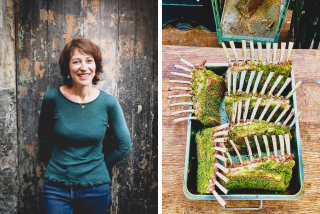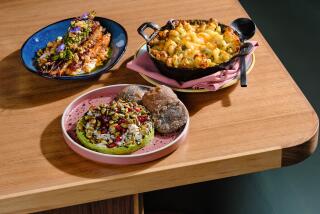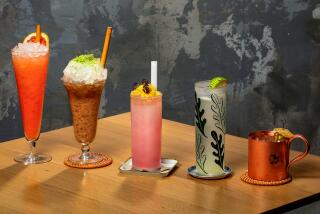An Old Flame
- Share via
Everyone seems to have a restaurant job story to tell. Mine dates back to college in Santa Cruz, and it came about by accident. I had gone with my girlfriend to check out a new place, La Goulue (“The Glutton”), named after a dancer made famous in paintings by Toulouse-Lautrec. I remember loving the meal and talking to the chef afterward to learn how the food had been prepared, especially a steak flambee in cognac.
He surprised me by asking if I wanted a job. I wasn’t looking, but they hired me as a general helper. I only lasted a couple of days in the kitchen, but the chef nonetheless made a strong impression, and I particularly remember how he loved to use cognac as part of a complex sauce, or just a shot splashed over a cut of meat he would then flame dramatically on the stove for an added burst of flavor.
I still use cognac in the kitchen at home. Of course, I mostly just drink the stuff while cooking, but Southern California chefs have inspired me to think outside the glass.
Robert Gadsby uses Cognac in his house-cured salmon and foie gras au torchon at Noe, while it turns up in Chris Andrews’ steak au poivre at Linq and Christophe Eme’s lobster at L’Orangerie.
At Encore in the St. Regis Los Angeles, newly arrived chef Toni Robertson makes it a key ingredient in her braised pork loin with roasted root vegetables and a fig gratin. She combines shallots, peppercorns, bay leaf, veal demi-glace and salt and pepper with cognac, yielding a viscous sauce both savory and sweet.
And while Robertson serves her cognac sauce with pork, she says it will work equally well with beef, veal, lobster and scallops, even baked tofu. Only tuna strikes Robertson as a bad partner for the versatile sauce, which she says has a “nice richness and perfume.”
She uses Courvoisier VSOP, but says any type will do, though it’s best to avoid cheaper cognacs as their harsh aromas only get worse in the cooking process.
Maurice Hennessy, whose family produces Hennessy cognacs, cautions cooks experimenting with cognac to avoid alcohol enhancers such as peppers, chiles and other hot spices that can make the alcohol seem stronger than it really is.
While every cognac is different, they do share common flavors and aromas, from spicy and floral to fruity and earthy. The better the cognac, the more it will bring to the dish. It would be silly, if not wasteful and wildly expensive, to use high-end X.O.-level (“extra old”) Cognacs in cooking, but it could be disastrous to use an inexpensive V.S. (“very superior”). The mid-level V.S.O.P. (“very superior old pale”) may be the best way to go.
At least for cooking. I’ll probably be sipping some X.O. while I stand over the stove.
*
Cognac Sauce
Makes 1 cup
1 cup veal demi-glace
2 shallots, sliced
1/3 cup cognac
3 peppercorns
1 bay leaf
Salt and pepper to taste
Bring veal demi-glace, shallot, bay leaf and peppercorns to boil. Reduce by half, about 7 minutes.
Add cognac, reduce by half again, about 5 minutes. Season to taste with salt and pepper.
Serve over braised pork, veal or beef.
More to Read
Eat your way across L.A.
Get our weekly Tasting Notes newsletter for reviews, news and more.
You may occasionally receive promotional content from the Los Angeles Times.










